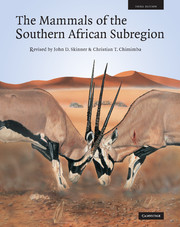Book contents
- Frontmatter
- Contents
- Editorial board
- Acknowledgements
- Foreword
- Preface
- The Mammal Research Institute
- R. H. N. Smithers
- Explanatory notes
- SUPERCOHORT AFROTHERIA
- COHORT PAENUNGULATA
- SUPERCOHORT EUARCHONTAGLIRES COHORT GLIRES
- COHORT EUARCHONTA
- SUPERCOHORT LAURASIATHERIA
- COHORT FERUNGULATA
- Order CARNIVORA
- Order PERISSODACTYLA
- Order SUIFORMES
- Order WHIPPOMORPHA
- Order RUMINANTIA
- Bibliography
- Appendix 1 Conservation status of southern African mammals
- Appendix 2 Colloquial names
- Index of scientific names
- Index of English colloquial names
- List of subscribers
- Plate Section
- Plate Section
- Plate Section
- Plate Section
- Plate Section
- Plate Section
- Plate Section
Order SUIFORMES
from COHORT FERUNGULATA
Published online by Cambridge University Press: 05 July 2013
- Frontmatter
- Contents
- Editorial board
- Acknowledgements
- Foreword
- Preface
- The Mammal Research Institute
- R. H. N. Smithers
- Explanatory notes
- SUPERCOHORT AFROTHERIA
- COHORT PAENUNGULATA
- SUPERCOHORT EUARCHONTAGLIRES COHORT GLIRES
- COHORT EUARCHONTA
- SUPERCOHORT LAURASIATHERIA
- COHORT FERUNGULATA
- Order CARNIVORA
- Order PERISSODACTYLA
- Order SUIFORMES
- Order WHIPPOMORPHA
- Order RUMINANTIA
- Bibliography
- Appendix 1 Conservation status of southern African mammals
- Appendix 2 Colloquial names
- Index of scientific names
- Index of English colloquial names
- List of subscribers
- Plate Section
- Plate Section
- Plate Section
- Plate Section
- Plate Section
- Plate Section
- Plate Section
Summary
THE FAMILY IS divided into three subfamilies comprising five genera and 16 species (Grubb, 1993c). The subfamily Babyrousinae occurs extralimitally, while the subfamilies Phacochoerinae and Suinae are each represented in the subregion by one species.
Outside the African continent the fossil remains of suids are known from Oligocene deposits of around 30 Mya. In Africa they are first known from the Lower Middle Miocene beds in Namibia (about 20 – 15 Mya), from which Xenochoerus africanus (Stromer, 1926) was described (Cooke & Wilkinson, 1978). Suids are sparsely known from the Pliocene but are common in Pleistocene deposits (about 1.8 – 0.1 Mya), from which numerous species have been described. Some species from this epoch, such as Notochoerus capensis Broom, 1925, from the Vaal River gravels, were very large, being nearly twice the size of the extant warthog (Phacochoerus africanus). Broom (1948) described P. antiquus (? modestus) from Kromdraai, also represented at Sterkfontein (Cooke, 1994), Swartkrans and Bolt's Farm (Cooke, 1993b) and Cornelia (McKee, 1995). Ewer (1956b) considered P. antiquus to lie morphologically between Phacochoerus and Potamochoerus and proposed placing it in the subgenus Potamochoerops. Harris & White (1979) proposed placing it in the genus Metridiochoerus. The fossil species Potamochoeroides shawi is particularly well represented at Makapansgat (Bender, 1992) and is also represented at Sterkfontein and Bolt's Farm (Cooke, 1993b). Metridiochoerus is represented at Bolt's Farm and Swartkrans Member 1 (possibly M. jacksoni) and Swartkrans Member 2 (M. andrewsi). Fossil remains of bushpigs are rare in Africa, even in the Late Pleistocene.
- Type
- Chapter
- Information
- The Mammals of the Southern African Sub-region , pp. 547 - 555Publisher: Cambridge University PressPrint publication year: 2005
- 1
- Cited by



